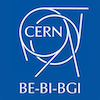Magnets provide magnetic field to spiral electrons and this way to decrease the impact of the beam space charge on the electron trajectory (see section Physics).
The magnets used in SPS and LHC BGIs are originally from ISR machine. The can be found in the database for normal-conducting magnets: NORMA.
They are larde-aperture correction dipoles with field of 0.2T. The main specifications (from NORMA) are:
- Description Correcting dipole, type IMHH-V, from ISR
- Family Corrector
- Cooling system Water
- Aperture width 200.0 mm
- Aperture height 200.0 mm
- Iron Length 430.0 mm
- Total Length 680.0 mm
- Total Width 750.0 mm
- Total Height 780.0 mm
- Weight 1100 Kg
- Dielectric Test Tension 3.0 KV
- Peak Current (cycled) 80.0 A
- RMS current 80.0 A
- Resistance 20°C 1235.0 mΩ
- Inductance 870.0 mH
- Delta P nominal 5.0 bar
- Nominal Cooling Flow 6.2 l/min
- Delta T Nominal 25.0 °C
- Lamination Thickness 1.5 mm
- Dipole Nominal Field at Peak Current 0.26 T
- Dipole Integrated Field at Peak Current 0.14 Tm
In both: LHC and SPS, there is always one corrector magnet in addition to the magnet holding the detector.
This scheme, with a single corrector, does not provide a closed orbit bump, but beam displacement, especially in LHC, is small. In SPS a three-magnet scheme was used. Disadvantage of the 3-magnet scheme is that the middle magnet must be powered with twice the current of side magnets, which means use of two different power converters. In case of failure of one of the power converters the beam will deviate from nominal orbit and will be lost on the aperture. Therefore it was tested and decided to use at SPS also only one corrector magnet (ref. Gilles Le Godec).
The equipment owner is Roberto Lopez.
To consignee the magnets in LHC contact: Gerard Pastor.
To consignee magnets in SPS (or do any works involving magnet moving) contact: Pascal Catherine or Jeremie Bauche.
Mariusz Sapinsk... on
